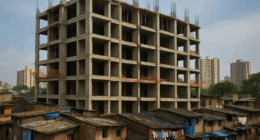- Net absorption in Q4 2023 reached a historic high of 16.01 mn sq ft, topping the previous record of 14.09 mn sq ft observed in Q4 2019
- Gross leasing activity in 2023 totalled 62.98 mn sq ft, setting yet another historic milestone
- Bengaluru and Delhi NCR led the way with a combined share of ~46.7% in gross leasing activity, followed by Chennai, which witnessed never-before-seen leasing activity
JLL India states that the net absorption in India’s top seven office markets breached the 40 mn sq ft mark and stood at 41.97 mn sq ft in 2023. This not only marks a new post-COVID milestone but also positions it as the second highest annual absorption, trailing only the levels recorded in 2019.
The year has set the platform for India’s office market to enter a phase of ‘accelerated growth’. While net absorption in the first half of the year was subdued, the pace of expansion from corporates quickened in the latter half of the year, reaching unprecedented heights in the final quarter. As a result, office net absorption during the year exceeded even the best scenario estimates of 39.0 mn sq ft as per JLL’s 2023: Year in Review report. This growth was fueled by India’s talent and cost arbitrage, along with its growing reputation as an innovation and R&D hub. The capacity addition in terms of both office space and headcount further validates the confidence in India’s business environment.
| Net Absorption (mn sq ft) | Q3 2023 | Q4 2023 | Q-O-Q Change (%) | 2022 | 2023 | Y-O-Y Change (%) | |||||||
| Bengaluru | 2.38 | 2.86 | 20.4% | 9.05 | 9.01 | -0.4% | |||||||
| Chennai | 0.90 | 3.32 | 268.8% | 3.26 | 6.61 | 102.8% | |||||||
| Delhi NCR | 1.70 | 2.23 | 31.1% | 6.16 | 7.25 | 17.6% | |||||||
| Hyderabad | 2.70 | 2.78 | 2.7% | 8.96 | 6.89 | -23.1% | |||||||
| Kolkata | 0.14 | 0.41 | 184.6% | 0.68 | 1.35 | 99.1% | |||||||
| Mumbai | 1.53 | 2.61 | 70.6% | 5.65 | 6.00 | 6.2% | |||||||
| Pune | 1.01 | 1.80 | 77.9% | 4.24 | 4.87 | 14.9% | |||||||
| Pan India | 10.37 | 16.01 | 54.4% | 38.00 | 41.97 | 10.5% |
Source: Real Estate Intelligence Service (REIS), JLL Research
“The current year is set to be entrenched as a pivotal chapter in the growth story of India’s office market. Gross leasing in India’s top seven markets exceeded the 60 mn sq ft milestone for the very first time, reaching an impressive 62.98 mn sq ft, a significant 26.4% y-o-y increase. Notably, Q4 2023 proved to be the busiest quarter ever, with gross leasing reaching 20.94 mn sq ft.. Additionally, the growth-oriented ecosystem in India continues to be a lucrative magnet for both domestic and foreign occupiers. Global corporations are channelling substantial investments into their India operations, while domestic occupiers are pursuing expansion strategies in response to this trend. In a year marked by global headwinds, these achievements are a testament to the market’s strong underlying fundamentals and growth prospects. They also solidify India’s position and firmly establish its credentials as the ‘office to the world’’, said Rahul Arora, Sr. MD – Karnataka and Kerala; Head – Office Leasing Advisory and Retail Services, India
Bengaluru and Delhi NCR lead the way, unprecedented market activity in Chennai
Bengaluru and Delhi NCR emerged as clear frontrunners in the market, accounting for 24.6% and 22.1% of the overall gross leasing in 2023, respectively. Chennai, the surprise package, followed with a significant share of 15.1%. Notably, it achieved a historic high of 9.50 mn sq ft in gross leasing during the year. Hyderabad followed closely with 9.26 mn sq ft. Mumbai and Pune followed in that order. Kolkata witnessed a resurgence in market activity with gross leasing recorded at a historic high of 1.90 mn sq ft.
In Q4 2023, Bengaluru maintained its leadership position with leasing activity amounting to 5.56 mn sq ft, followed by Delhi NCR at 3.80 mn sq ft. Chennai exhibited remarkable growth with quarterly leasing recorded at 3.41 mn sq ft. Hyderabad and Mumbai also demonstrated strong activity, with 2.74 mn sq ft and 2.70 mn sq ft, respectively.
GCCs and flex occupiers remain key drivers of leasing activity
India’s growth-oriented ecosystem continues to attract both domestic as well as foreign occupiers, as global corporations make significant investments into their India operations and domestic occupiers follow expansion strategies.
However, there has been a shift in demand composition, with the tech sector’s share decreasing to 20.9% in 2023, its lowest in over a decade. This decline can be attributed to the sluggish space take-up by third-party outsourcing firms, given global headwinds and slower revenue growth.
In contrast, there has been increased traction from the manufacturing/industrial and BFSI sectors, particularly through the establishment of GCCs. Both segments set new records in leasing volume, with each leasing ~11.3 mn sq ft of office spaces during the year. Flex space providers also enjoyed greater occupier acceptance, leasing a historic high of ~10.3 mn sq ft. The consulting segment demonstrated robust demand as well, leasing ~6.1 mn sq ft, indicating sustained and secular demand across all major occupier categories.
In Q4, the tech sector saw a resurgence in space take-up, capturing a 23.2% share, followed by significant activity from the BFSI and the manufacturing/industrial segments. Flex space take-up was slightly slower in Q4, accounting for a share of 13.6%. Nonetheless, the segment continues to witness strong momentum, driven by managed space operators and high demand from occupiers across various industries.
Grade A office stock crosses the remarkable milestone of 800 mn sq ft
Grade A office stock in the top seven cities achieved a significant milestone, surpassing 800 mn sq ft, further solidifying India’s position as a prime destination for office spaces. In the fourth quarter of 2023, new completions kept pace with leasing activity, reaching 18.75 mn sq ft. New completions during the quarter were headlined by Hyderabad which accounted for a 33.4% share, followed by Mumbai with an 17.8% share. Bengaluru and Chennai followed with 14.3% and 13.5% shares, respectively.
For the entire year of 2023, new completions stood at 53.64 mn sq ft, a marginal decrease of 7.9% y-o-y. Hyderabad and Bengaluru combined to contribute 56.9% of the annual supply, with other significant contributors being Chennai and Delhi NCR.
Vacancy decreases by 10 bps
Vacancy on a pan-India basis stands at 16.7%, a modest 10 bps decrease q-o-q. Core markets and superior quality institutional assets continue to find favour from occupiers resulting in significantly lower vacancy rates, usually in the single digits. It reflects occupiers’ clear preference for such premium assets that possess sustainability certifications and aligns with their organizational objectives of enhancing employee satisfaction, maintaining high health and safety standards, promoting efficiency, and implementing corporate net-zero strategies.
Outlook: Net absorption to align more closely with 2019 levels
“India’s office market has demonstrated unmatched resilience and continues to defy global sluggishness, with strong underlying fundamentals supporting sustained growth in demand. Over the next 3-4 years, we anticipate that the market activity witnessed in 2019 will become the new norm. Net absorption levels in India’s office market will align more closely with 2019 levels, hovering in the 45 – 48 mn sq ft range. The market activity is expected to be primarily driven by the entry of new GCCs into the country, along with existing GCCs expanding their operations. Additionally, India’s manufacturing policies are likely to attract high-end R&D work. Flex space providers are also expected to continue their momentum as they become an integral part of occupiers’ portfolio strategies”, said Dr. Samantak Das, Chief Economist and Head of Research and REIS, India, JLL
Also Read: Office sector sees robust demand with projected net absorption of 37-39 mn sq ft in 2023









